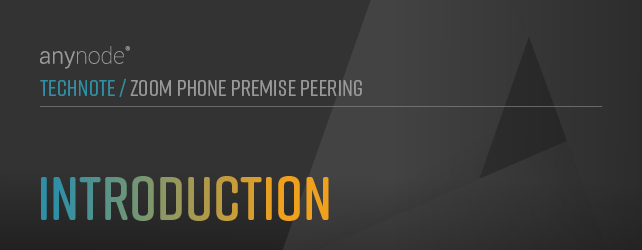
Introduction
This training will show the various aspects of setting up and configuring Zoom Phone Premise Peering and anynode.
Configure Zoom Phone Premise Peering with anynode. Step-by-step guide for seamless integration, enhancing communication capabilities.
Welcome to the guide on configuring Zoom Phone Premise Peering with anynode - The Software SBC. This training will show the various aspects of setting up and configuring Zoom Phone Premise Peering and anynode.
We will cover key chapters, including the Zoom Web Portal Configuration, the Zoom Node, Provider Node, and Routing. These chapters will provide a step-by-step guide on configuring the necessary settings for seamless integration between Zoom Phone Premise Peering and anynode.
-
In the Zoom Web Portal Configuration chapter, we will take care of how to configure Zoom Phone Premise Peering through the Zoom Phone Admin Web Portal with anynode as a session border controller.
-
The Zoom Phone Premise Peering Configuration Example chapter will guide you through the initial setup process for Zoom Phone Premise Peering. You will learn how to configure the necessary credentials, trunks, and endpoints to establish a functional connection and enable seamless communication between your existing telephony infrastructure and Zoom Phone.
-
In the Zoom Node chapter, we will delve into the essential configuration steps required for anynode SBC. You will learn how to set up and fine-tune the node parameters, ensuring optimal performance and compatibility with Zoom Phone Premise Peering.
-
Moving on to the Provider Node chapter, we will focus on the specific settings required to establish a connection between anynode and a provider. This section will cover authentication, routing, and other important configurations to ensure a secure and reliable communication channel.
-
In the Routing chapter, we will explore advanced routing configurations within anynode. This section will equip you with the knowledge and skills to optimize call routing, implement rules for inbound and outbound calls, and handle various scenarios effectively.
-
Finally, to verify the configuration, the Configuration Check chapter describes initiating and evaluating a test call and creating a Trace using the anynode Trace Analyzer.
By the end of this training, you will have a solid understanding of how to configure Zoom Phone Premise Peering with anynode – The Software SBC. You will be equipped with the necessary knowledge to set up, manage, and troubleshoot the integration, empowering you to enhance communication capabilities within your organization.
The documentation, screenshots, and configuration examples in this document are based on anynode version 4.10.
To learn more about Zoom Phone Premise Peering installation and configuration, consult Zoom's documentation.
To find information and documentation related to anynode, check our websites anynodesbc.com and TE-SYSTEMS Community.